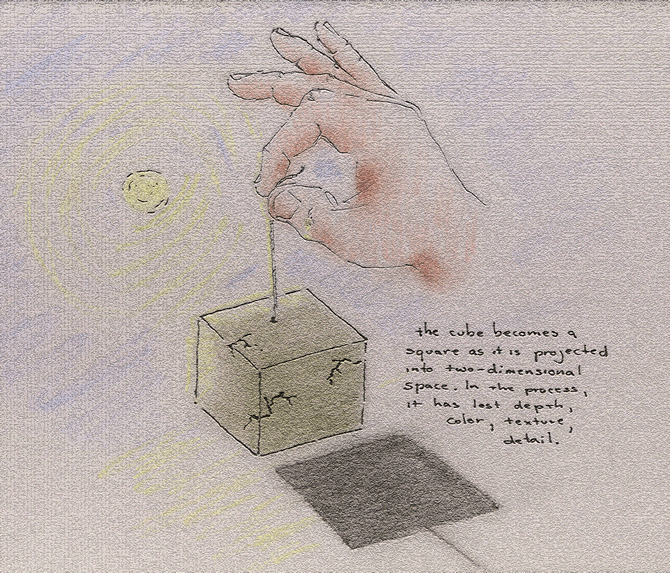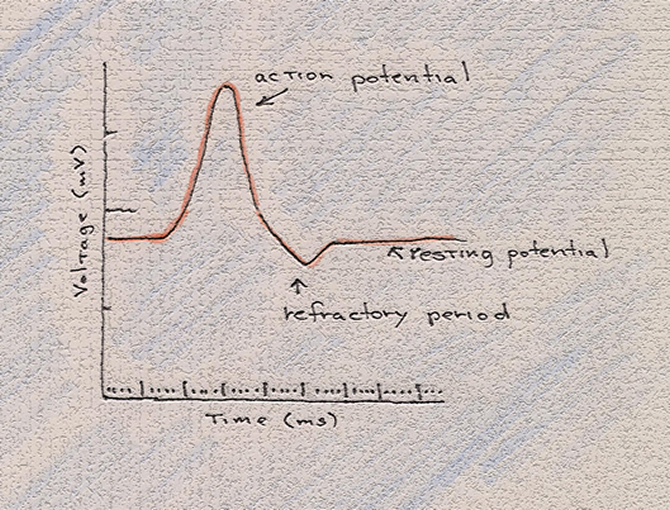Vision
So, where are we?
We have described, to some extent, the manner in which our world is showered with electromagnetic radiation, a very narrow band of which is sensible to the cells that line the back of the eye. We have aslo described, to some extent, the manner in which these cells, these photoreceptors, absorb discrete measures of that radiation in the form of photons and momentarily change shape. We then went on to describe how that change in shape or conformation ultimately resulted in a signal conveyed along nerve tracts projecting from the back of the eye to the back of the brain—to area V1, the primary visual cortex.
But how does this equate with vision? How, finally, do we see?
The Shadow World of the Senses
The information entering the eye and conveyed to the brain is compromised at nearly every point. Consider, for the moment, that the light-configured scene projected upon the retina is smaller than its real-world antecedent, upsidedown and two-dimensional. Moreover, the image qua image at this stage is of little consequence to the brain; it must first be transduced into neural impulses. Transduction involves the conversion of one form of energy (as information) into another form with an inevitable loss of energy (or information) as dictated by the second law of thermodynamics. Further to the point, the resulting signal train (or information) is compressed as it is passed from photoreceptors to bipolar cells to ganglion cells to the brain. And the brain, in turn, must shuttle some of the information to nuclei that are ancillary, or even occasionally irrelevant, to the primary visual cortex.
The ever-rarefied sensory information upon which the brain acts is, in the end, a kind of shadow of the world in which it lives. Compare, for example, the information contained in the cube with that contained in its square shadow:

As the cube is projected into two-dimensional space, it loses the dimension of depth as well as such attributes as color, texture and detail. Consider, then, having faithfully to reconstruct the original three-dimensional object from its shadow.
And now consider how the brain has to re-imagine the scene within the subject's purview based only or largely upon signal trains and their frequencies plotted against density-biased cortical maps.
One Signal Can Mean Many Things
Ganglion cell axons send information to the brain in the form of nerve impulses or action potentials. Though the signals may vary in frequency, which is a measure of the intensity of the stimulus, all such signals--all such action potentials--look the same when plotted against a graph:

--a spike along the line indicating the membrane potential of the cell under study.
But the information conveyed by the ganglion cell axon to this or that layer of this or that brain nucleus will vary by virtue of the fact that this forever same-looking signal is associated with this or that aspect of the stimulus: i.e., the signal is the same but its referent is not.
So, for example, the ganglion cell may be pulsing in response to light energy which, when mapped or measured against impulses from other ganglion cells covering other receptive fields, can be used by nuclei along the visual pathway to reconstruct line boundaries and/or spatial relationships between objects, motion or wavelength contrasts that ultimately evoke sensations of color.
These first signals are somewaht like language at the machine level in computers. There is a signal or no signal, an "on" or an "off," a 1 or a 0. Such signals, however, are essentially meaningless until they are placed within a context and made subject to rules for interpreting such signals within such contexts. A string of 1's and 0's can be used to create patterns of luminance on a screen, to type letters within a wordprocessing program or to search for arousing pixel configurations of Eastern Europe's loveliest citizens (or, so I have been told).
Similarly, signals conveyed from the retina to the brain will vary in their significance depending upon the nucleus to which they are sent, upon the layer of the nucleus in which they synapse and upon other signals with which they will be associated.
Some signals will be sent to the suprachiasmatic nucleus where they will serve as information regarding the time of day. Some signals will be sent instead to the superior colliculi where their information will be used in directing eye and head movement. Still others--the vast majority--will be conveyed along parallel pathways to and through the lateral geniculate nucleus and then to the striate cortex (V1) where they may be projected back to the lateral geniculate nucleus or forwarded to other vision-related nuclei (V2, V3, V4, V5) and subject to further processing in new contexts under new rules.
Filling In
An important aspect of large stretches of cognitive activity and, more particularly, of vision involves "filling in," a term used to designate those occasions when we infer the existence of something for which there is no direct sensory evidence. Although occasionally misleading, "filling-In" allows us to move through the world without having always to re-explore regularly-occurring phenomena terminated by anticlimactic revelations of sameness.
Phenomena consonant with apparent observation are allowed to recede from memory, enabling the brain to jump from one level of reasoning to another without having to cover every intervening step along the particular course.
[...]
...we say "supposed," say "theory," because the perception is of something for which data has had to be imagined. The light arriving at the retina does not include data regarding the occluded parts of the object, which are neverless included in our notion that we are staring at somethiong three-dimensional, in our strong expectation that lines portending its shape are not coincidental unless chaotically unique. "Chaotically unique" we say, as it would require us to examine every new thing as an unpredictable single occurrence for which we would have to provide always the same amount of time, focus and energy. We could only react, never act, were we unable to build models incorporating prediction.
[Our apologies as this section is still to be edited]